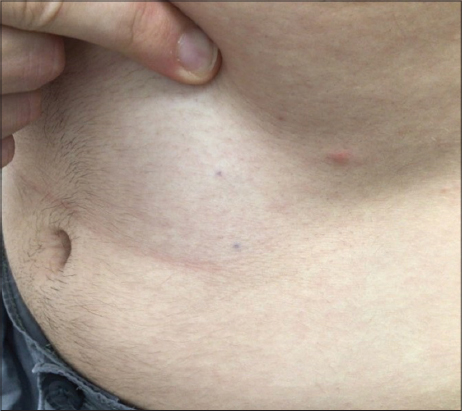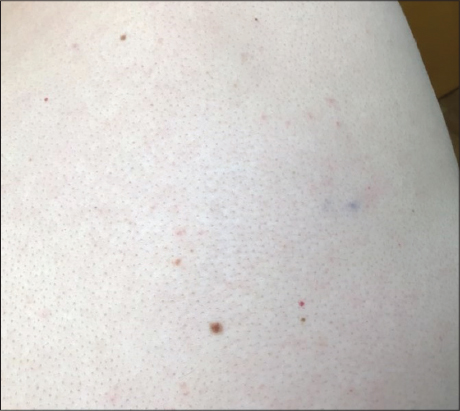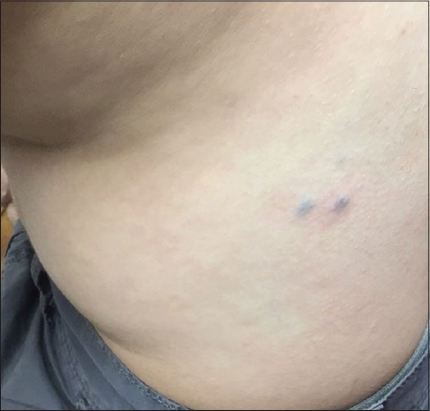Blue rubber bleb nevus syndrome
Zachary Kolansky 1, Glenn Kolansky2
1, Glenn Kolansky2
1Tulane University School of Medicine, New Orleans, LA, USA 2Director of Advanced Dermatology Surgery and Laser Center, Tinton Falls, NJ, USA
Corresponding author: Glenn Kolansky, MS, MD, E-mail:
How to cite this article: Kolansky Z, Kolansky G. Blue rubber bleb nevus syndrome. Our Dermatol Online. 2022;13(2):213-214.
Submission: 17.10.2021; Acceptance: 23.01.2022
DOI: 10.7241/ourd.20222.24
Citation tools:
Copyright information
© Our Dermatology Online 2022. No commercial re-use. See rights and permissions. Published by Our Dermatology Online.
We present an unusual case of a rare vascular disorder known as blue rubber bleb nevus syndrome (BRBNS). While many cases of BRBNS occur sporadically, some have been associated with an autosomal dominant inheritance pattern with a locus on chromosome 9p [1]. Furthermore, BRBNS causes vascular malformations to occur in the skin and the gastrointestinal (GI) tract. GI bleeding is a common cause of morbidity in these patients [2]. This syndrome affects males and females in equal numbers [3].
A nineteen-year-old male presented with several soft, blue, and easily compressible papules on the trunk (Figs. 1 – 3). These papules were painful to palpation and had been present for years. The patient was referred to a dermatologist by the pediatrician as new papules described recently appeared. Additionally, an ultrasound of the trunk interpreted the areas involved as lipomas. The pertinent history includes the diagnosis of BRBNS in the patient’s uncle and diagnosed with BRBNS by the dermatologist. Finally, the patient was referred to gastroenterologist consultation for colonoscopy to evaluate possible vascular malformations in the GI tract.
 |
Figure 1: Soft, easily compressed, dark blue papules on the abdomen. |
 |
Figure 2: Soft, easily compressed, dark blue papules on the back. |
 |
Figure 3: Dark blue papules on the flank. |
Consent
The examination of the patient was conducted according to the principles of the Declaration of Helsinki.
The authors certify that they have obtained all appropriate patient consent forms, in which the patients gave their consent for images and other clinical information to be included in the journal. The patients understand that their names and initials will not be published and due effort will be made to conceal their identity, but that anonymity cannot be guaranteed.
REFERENCES
1. Krishanappa A, Padmini J. Blue rubber bleb nevus syndrome. Indian J Pathol Microbiol. 2020;53:168-70.
2. Bolognia JL, Jorizzo J L, Schaffer JV. Dermatology (3rd ed.). Volume 2. Elsevier Saunders. Section 17:Vascular Disorders. 1720-1. 2020. ISBN:9780723435716.
3. Fishman SJ, Mulliken JB. Blue Rubber Bleb Nevus Syndrome. In:The Nord Guide to Rare Disorders, Philadelphia:Lippincott, Williams and Wilkins;2003:160.
Notes
Source of Support: Nil,
Conflict of Interest: None declared.
Request permissions
If you wish to reuse any or all of this article please use the e-mail (brzezoo77@yahoo.com) to contact with publisher.
| Related Articles | Search Authors in |
|
|



Comments are closed.